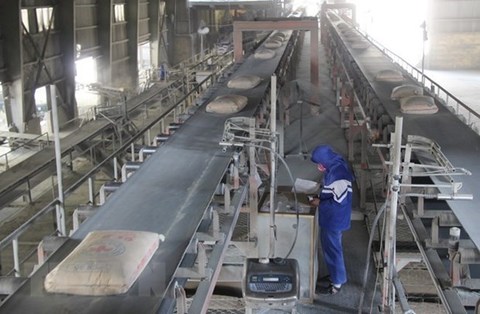
A cement plant. The construction materials market in HCM City started to flourish again in the third quarter as the peak construction season began and demand from some export markets recovered. — VNA/VNS Photo
After a gloomy period due to the COVID-19 pandemic, the construction materials market in HCM City started to flourish again in the third quarter as the peak construction season began and demand from some export markets recovered.
Many business and construction materials shops are preparing supplies to meet the needs for the peak construction season of the year. Items such as steel, bricks, tiles, sanitary wares are selling well.
With a wide range of models, good quality and reasonable prices, locally made construction materials are increasingly capturing the domestic market, according to traders.
Owners of building materials shops on To Hien Thanh Street in District 10 said that prices of most construction materials have not increased, and some even reduced to boost sales.
Currently, locally made floor tiles are priced from VND80,000 (US$3.4) to VND250,000 ($10.7) per square metre depending on brands, while those imported from Malaysia, Italy, and Spain range from VND400,000 ($17.1) to VND1.3 million ($55.6) per square metre.
Paint manufacturers are offering attractive discounts to agents and customers, while lighting and decorative lamps have seen prices discounted by 30-40 per cent.
Unlike previous years when the construction materials prices usually increased significantly in the final months of the year, prices this year have been rather stable or have even fallen.
Cement prices, for instance, have fallen by VND70,000-100,000 per tonne to VND1.1 million-VND1.27 million per tonne depending on brands. Traders attributed the fall in cement prices to supply outstripping demand.
Iron and steel prices are forecasted to remain unchanged until the year-end, they said.
According to experts, demand for construction materials usually spikes near year-end when developers speed up construction of housing projects and people renovate their houses to welcome the Lunar New Year.
In addition, ministries, agencies and localities are speeding up the construction progress of public investment projects in order to disburse public investment capital on schedule as directed by the Prime Minister.
Export increase
Despite difficulties, the steel industry exported nearly seven million tonnes of iron and steel for a value of $3.65 billion in the first nine months of the year, a year-on-year increase of 44.4 per cent in volume and 16 per cent in value.
China was the largest buyer of Vietnamese iron and steel, accounting for 36.2 per cent of total export volume and 28.5 per cent of total export revenue, followed by Cambodia and Thailand.
According to the Ministry of Industry and Trade, in the first nine months of 2020, the cement industry exported over 28 million tonnes of products, earning $1.03 billion compared to 23.24 million tonnes and $973 million in the same period last year.
“Compared to the same period in 2019, cement and clinker exports have increased by nearly 21 per cent in volume and 6.2 per cent in value. The increase here was mainly driven by the rise in export volume, not the export price,” a representative of the ministry said.
Cement firms will have opportunities to boost exports when many countries resume normal operations.
Viet Nam’s steel exports to China are expected to increase since China has tightened policy that aims to shut down steel plants using outdated technologies.
The Comprehensive and Progressive Agreement for Trans-Pacific Partnership and the EU – Viet Nam Free Trade Agreement have opened export opportunities for the local steel industry in these markets, he said.
However, the steel industry has encountered fierce competition with imported steel products in the domestic market, experts have said, adding that the industry has also had to deal with trade remedy investigations in export markets.
Therefore, businesses need to regularly update information on the export situation and cooperate with authorities in handling of trade remedy investigations, they said.
To reduce risks, they suggested the steel sector to perfect its production process and improve its competitiveness. In particular, they need to form a closed manufacturing cycle from input materials to production, and gradually eliminate the use of imported raw materials. — VNS